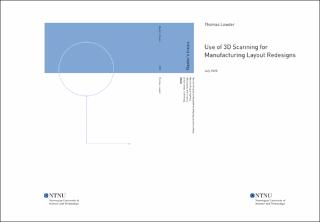| dc.description.abstract | Manufacturing companies are constantly looking for ways to improve profit margins and stay competitive, and a common solution is the redesign of the manufacturing layout. During the process of designing a layout, visual tools, such as drawings or 2D CAD, are used to present visual data and analyses. However, there are many drawbacks to these traditional visual tools. This thesis researches the use of an emerging digital technology, 3D scanning, to create visual tools to be used for the redesign of a manufacturing layout using a simplified version systematic layout planning (SLP).
The objective of this thesis is to understand the capabilities of 3D scanning and how the respective visual tools can be used to support the manufacturing layout redesign using the SLP pattern of procedures. The goal is to improve the layout design process for an operations manager by reducing the overall time and increasing visual understanding and quality of the layout design and analyses.
The research of this thesis is structured around the following three research questions.
1. What is the state-of-the-art for the use of 3D scanning for manufacturing facility layouts?
2. How do 3D scanning types, photogrammetry and structured light compare when used for manufacturing facility layouts?
3. How do 3D scanned visual tools support the process of redesigning a manufacturing layout using the SLP pattern of procedures?
A state-of-the-art literature review explored recent research on the use of 3D scanning for manufacturing facility layout designs. The literature review found that laser scanning was the most used type of 3D scanning. Moreover, most of the research was based on the layout of one production system and not the overall layout. Hence, a gap in research was discovered, which led to the formulation of research questions two and three.
An empirical case study is used to examine the remaining research questions. First, an experiment is used to create a visual tool of the current manufacturing layout design using structured light and photogrammetry 3D scanning. The scanning process and visual tools of each are then compared on specific quantitative and qualitative performance metrics.
The better visual solution from the experiment is used to create a new layout using a simplified version of the SLP pattern of procedures. Qualitative observations on how the 3D scanned visual tools support the pattern of procedures are made throughout the process.
The results suggest structured light as the better overall scanning type for manufacturing layout redesigns. Additionally, the visual tools produced by structured light can support and improve the SLP process. | |
